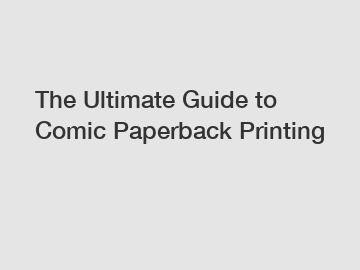The Ultimate Guide to Comic Paperback Printing
The Ultimate Guide to Comic Paperback Printing.
Comic books have been a beloved form of entertainment for decades, captivating readers with their unique blend of storytelling and artwork. For aspiring comic book creators, getting their work printed and published is a momentous achievement. However, the process of comic book paperback printing can be complex and overwhelming. This comprehensive guide aims to provide all the essential information you need to navigate the world of comic paperback printing successfully.
Choosing the Right Printing Company.

The first step in bringing your comic book to life is selecting the right printing company. Look for one that has experience in printing comic books specifically, as they will have a better understanding of the specialized requirements of the medium. Consider factors such as printing quality, turnaround time, and pricing options to find a printing company that suits your needs.
Formatting Your Comic Book.
Before submitting your comic book for printing, it's crucial to ensure that it is properly formatted. The standard size for comic books is 6.625 x 10.25 inches, but you can choose alternative sizes based on your preferences. Make sure to leave a sufficient border around the artwork to avoid any critical elements being trimmed during the printing process. Additionally, convert all images to CMYK color mode for accurate color reproduction.
Choosing the Right Paper and Binding.
Selecting the right paper and binding options for your comic book is essential to achieve the desired look and feel. For the interior pages, choose a paper weight that complements the artwork and does not compromise its visibility. Matte, gloss, and satin finishes are popular choices for comic book printing, so consider the aesthetics you want to convey.
As for binding, there are several options to consider, including saddle-stitching and perfect binding. Saddle-stitching is commonly used for thinner comic books with fewer pages, while perfect binding works best for thicker volumes. Discuss these options with your printing company to determine the most suitable choice for your comic book.
File Preparation and Proofing.
When preparing your files for printing, make sure to follow the guidelines provided by your chosen printing company. Convert your comic book files to PDF format, ensuring that all fonts and images are embedded. Double-check for any errors or formatting issues that may affect the final printed result. Request a printed proof from your printing company to ensure that everything looks exactly as intended before proceeding with a full print run.
Print Run and Distribution.
Once you have approved the printed proof, it's time to determine the appropriate print run for your comic book. Consider factors such as your budget, target audience, and marketing strategy when deciding on the quantity to print. Some printing companies also offer fulfillment services, allowing you to streamline the distribution process. Alternatively, you can explore self-distribution options or collaborate with local comic book shops.
Conclusion.
Comic paperback printing can be a complex process, but with proper planning and research, you can successfully bring your comic book to life. Remember to choose a reputable printing company, format your comic book correctly, select suitable paper and binding options, and thoroughly proof your files. Additionally, think strategically about your print run and distribution channels to reach your target audience effectively. By following this ultimate guide, your comic book will be one step closer to making a lasting impression on readers.
For more information about comic paperback printing and how we can assist you in bringing your vision to life, please contact us.
Are you interested in learning more about custom embossed book cover, custom embossed book cover, hardcover book printing with debossing? Contact us today to secure an expert consultation!


